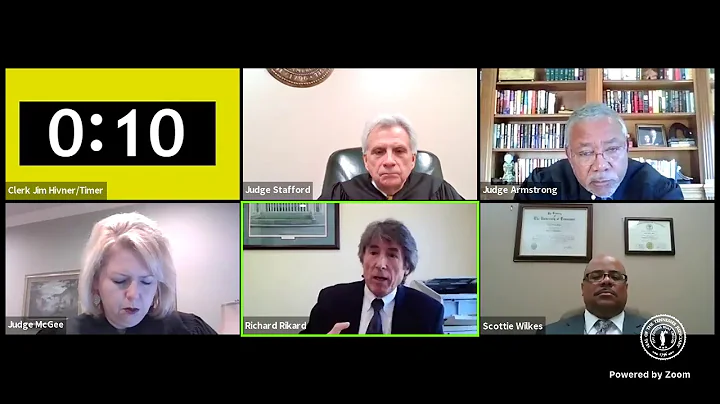Yolanda L Carter
age ~36
from Philadelphia, PA
- Also known as:
-
- Yolander Carter
- Phone and address:
- 7034 Glenloch St, Philadelphia, PA 19135
Yolanda Carter Phones & Addresses
- 7034 Glenloch St, Philadelphia, PA 19135
- Avondale, OH
Us Patents
-
Methods And Apparatus For Delivering Tissue Treatment Compositions To Stapled Tissue
view source -
US Patent:20110278346, Nov 17, 2011
-
Filed:May 11, 2010
-
Appl. No.:12/777449
-
Inventors:Joanne Hull - Cincinnati OH, US
Wells D. Haberstich - Loveland OH, US
Steven G. Hall - Cincinnati OH, US
John A. Hibner - Mason OH, US
Julia J. Hwang - Wayland MA, US
Yolanda F. Carter - Union KY, US
John B. Schulte - West Chester OH, US
Rebecca J. Mollere - Loveland OH, US
Patrick D. Dugan - Madeira OH, US
Michael D. Cronin - Cincinnati OH, US
Jerome R. Morgan - Cincinnati OH, US -
International Classification:A61B 17/068
A61F 2/02 -
US Classification:2271801, 2271761, 623 1111
-
Abstract:A surgical stapler includes first and second tissue clamping members and a reservoir configured to hold a tissue treatment composition. The first tissue clamping member is configured to receive a plurality of staples. The second tissue clamping member comprises an anvil configured to form the staples. The reservoir may be provided in a handle portion of the surgical stapler, and a fluid conduit may be used to communicate the tissue treatment composition from the reservoir. An end effector lumen may selectively communicate with the fluid conduit. The lumen may also be in communication with openings to further communicate the tissue treatment composition to tissue or to a scaffold material positioned adjacent to tissue. A reservoir may alternatively be provided in one of the clamping members. A knife member may pierce a housing defining the reservoir, and a resilient member may then urge a tissue treatment composition from the housing.
-
Instrument For Debriding Tissue And Applying Therapeutic Cells
view source -
US Patent:20110282270, Nov 17, 2011
-
Filed:May 13, 2010
-
Appl. No.:12/779137
-
Inventors:Steven G. Hall - Cincinnati OH, US
John A. Hibner - Mason OH, US
Julia J. Hwang - Wayland MA, US
Yolanda F. Carter - Union KY, US -
International Classification:A61B 17/32
A61M 37/00 -
US Classification:604 22
-
Abstract:A tissue treatment device comprises a housing having a chamber that receives a treatment fluid mixture of tissue morsels and a scaffold material. A debriding shaft including a plurality of cutters is coupled with the housing. The debriding shaft extends proximally within the chamber and extends distally from the end of the housing. The debriding shaft is inserted within a treatment site such as a fistula tract and is rotated and reciprocated such that the debriding shaft removes tissue cells along the site. The site is flushed with saline or other irrigating fluid followed by application of the treatment fluid mixture. The chamber of the housing comprises agitators positioned adjacent the debriding shaft. The treatment fluid mixture passes through the chamber of the housing along and between the outer surface of the debriding shaft and the agitators for thorough mixing before exiting the device at the treatment site.
-
Instrument For Debriding Fistula And Applying Therapeutic Cells
view source -
US Patent:20110282337, Nov 17, 2011
-
Filed:May 12, 2010
-
Appl. No.:12/778671
-
Inventors:Steven G. Hall - Cincinnati OH, US
John A. Hibner - Mason OH, US
Julia J. Hwang - Wayland MA, US
Yolanda F. Carter - Union KY, US -
International Classification:A61B 18/18
A61B 17/3205 -
US Classification:606 33, 606170, 606171
-
Abstract:A treatment system comprises an outer sheath and an end effector. The end effector has a plurality of cutting features, at least a portion of which are configured to debride a tissue surface when the end effector is actuated. The cutting features may also be configured to harvest tissue. A medical fluid reservoir is in fluid communication with the end effector, such that the end effector may deliver a medical fluid to a target site such as a fistula. The medical fluid may include harvested tissue cells and a scaffold material. A vacuum cannula may be positioned coaxially within the interior cavity of the end effector, and an RF probe may be positioned co-axially within the interior cavity of the vacuum cannula. The vacuum cannula and RF probe may be used together to seal a fistula in which medical fluid has been dispensed.
-
Fistula Repair Device With Extendable Barbs And Therapeutic Cell Delivery
view source -
US Patent:20110282368, Nov 17, 2011
-
Filed:May 12, 2010
-
Appl. No.:12/778587
-
Inventors:Jeffrey S. Swayze - Hamilton OH, US
Foster B. Stulen - Mason OH, US
Mark H. Ransick - West Chester OH, US
Steven G. Hall - Cincinnati OH, US
John A. Hibner - Mason OH, US
Julia J. Hwang - Wayland MA, US
Yolanda F. Carter - Union KY, US -
International Classification:A61B 17/22
A61B 17/00 -
US Classification:606159, 606213
-
Abstract:A fistula repair system includes a debriding member that may be inserted into a fistula to debride the fistula wall. The debriding member may include a plurality of selectively extendable barbs. The barbs may be hollow to deliver a medical fluid within the fistula. The debriding member may also include a plurality of openings configured to communicate the medical fluid within the fistula. The barbs may extend through the openings. The openings may include associated protrusions that are configured to debride the fistula wall. The medical fluid may include a slurry of tissue and a scaffold material. The tissue in the slurry may comprise minced tissue that was harvested from the patient afflicted with the fistula. A balloon may be used to at least temporarily seal one end of the fistula. An RF probe or mechanical hook member may be used to seal the other end of the fistula.
Resumes

Manager, Strategy Execution At Ethicon Endo-Surgery
view sourceLocation:
Cincinnati Area
Industry:
Medical Devices

Yolanda Carter
view sourceLocation:
United States

Yolanda Carter
view sourceLocation:
United States

Yolanda Carter
view sourceLocation:
United States
License Records
Yolanda Carter
Address:
Philadelphia, PA 19132
License #:
PN274269 - Active
Category:
Nursing
Type:
Practical Nurse
Yolanda Carter
Address:
Philadelphia, PA 19151
License #:
CL015537L - Expired
Category:
Cosmetology
Type:
Nail Technician
Plaxo

Yolanda Carter
view sourceImagine One Technology & Management
Flickr

Yolanda Watson Carter
view source
Yolanda Thompson Carter
view source
Yolanda Carter Mas
view source
Yolanda Carter Artis
view source
Yolanda Carter
view source
Yolanda Carter
view source
Yolanda Carter
view source
Yolanda Thtswhtsup Carter
view sourceClassmates

Yolanda Mangolini (Carter)
view sourceSchools:
Kathleen E. Goodwin Elementary School Old Saybrook CT 1977-1979, Old Saybrook Main Street School Old Saybrook CT 1979-1982, Old Saybrook Junior High School Old Saybrook CT 1982-1984, Cambridge School of Weston Weston MA 1984-1984
Community:
Tilo Brand, Laura Snelling, Laura Grayzel, Murray Burwick, Michael Kagan, Erik Rosengren, D White, Chris Brooke, Jonathan Griffith, Nina Hallowell, Katie Willis
Biography:
LifeI am married with a 3 year old son and 13-month old daughter. After spending a ...

Yolanda Linnen (Carter)
view sourceSchools:
Gordon High School Decatur GA 1973-1977
Community:
Judy Long, Sandra Young, Kathy Coons

Yolanda Carter (McLeod)
view sourceSchools:
North Forrest High School Hattiesburg MS 1988-1992
Community:
Michael Labiche, Anthony Kent, Michelle Verrett

Yolanda Carter
view sourceSchools:
Ethel High School Ethel MS 1994-1998
Community:
Annette Bennett, Sommone Ray, Bobby Johnson

Yolanda Carter
view sourceSchools:
Noxapater High School Noxapater MS 1983-1987
Community:
Randall Goldman, Devon Coburn, Anita Russell, Mckinley Triplett, Willie Edwards, Herman Glass

Yolanda Carter
view sourceSchools:
Central High School Talbotton GA 1989-1993
Community:
Mattie Carter, Joey Jackson, Melissa Willis, Tony Lamar, Judy Morton

Yolanda Carter
view sourceSchools:
Mid City Alternative High School Los Angeles CA 1974-1983
Community:
Michael Martinson, Patrick Mitchell, Glen Waugh, Raymundo Baca

Yolanda Carter
view sourceSchools:
WALTER L.COHEN HIGH New Orleans LA 1970-1974
Community:
Jerome Jacks, Kenneth Moore
News

The complicated legacy of Bengals coach Marvin Lewis
view source- There is Yolanda Carter, who graduated from Spielman College on a pre-med track. Or Ryan Reid, who graduated from Ohio State last year and took on the task of mentoring students at risk of dropping out with a 100 percent success rate. Or 2009 recipient LeAnn Clark, who credits the community fund for
- Date: Dec 29, 2017
- Category: Sports
- Source: Google
Googleplus

Yolanda Carter

Yolanda Carter

Yolanda Carter

Yolanda Carter

Yolanda Carter

Yolanda Carter

Yolanda Carter

Yolanda Carter
Youtube
Get Report for Yolanda L Carter from Philadelphia, PA, age ~36













